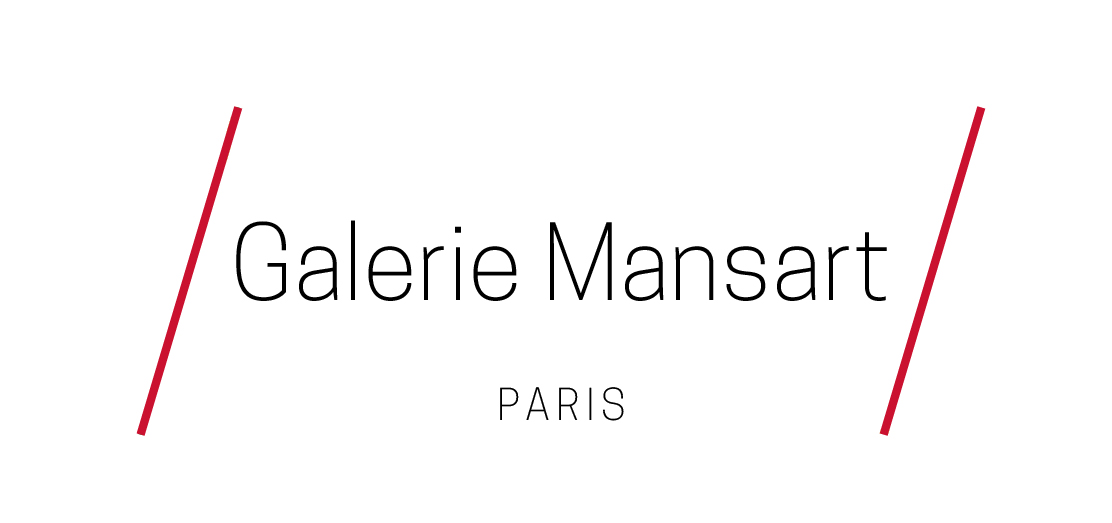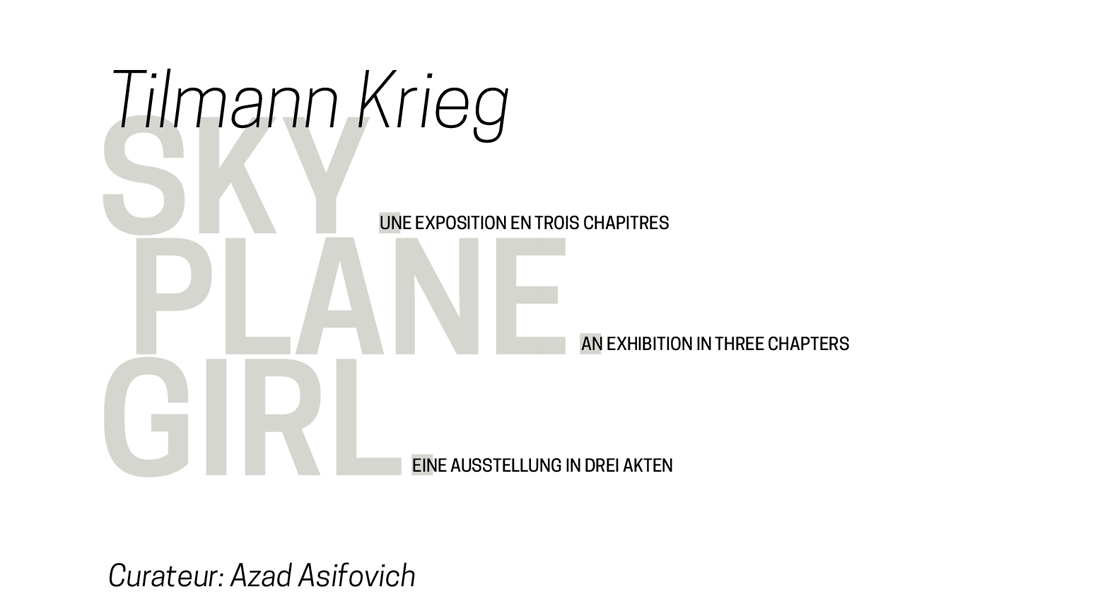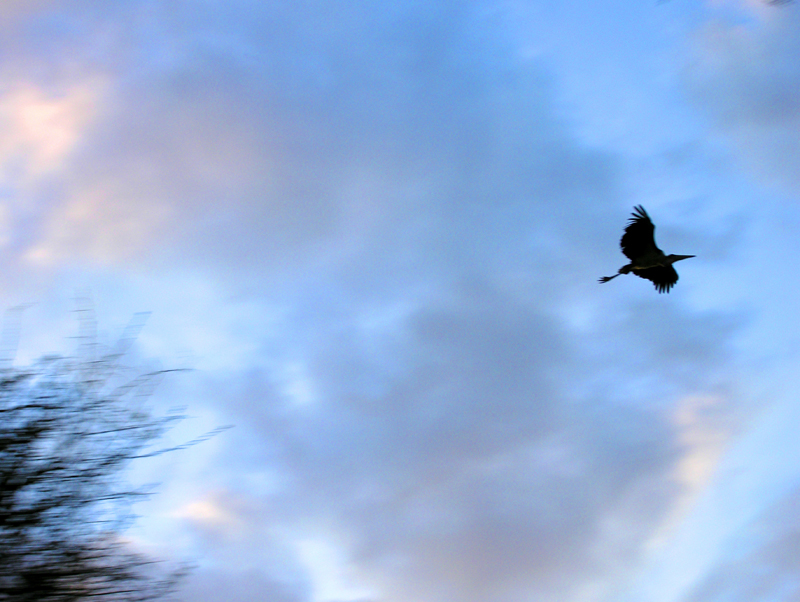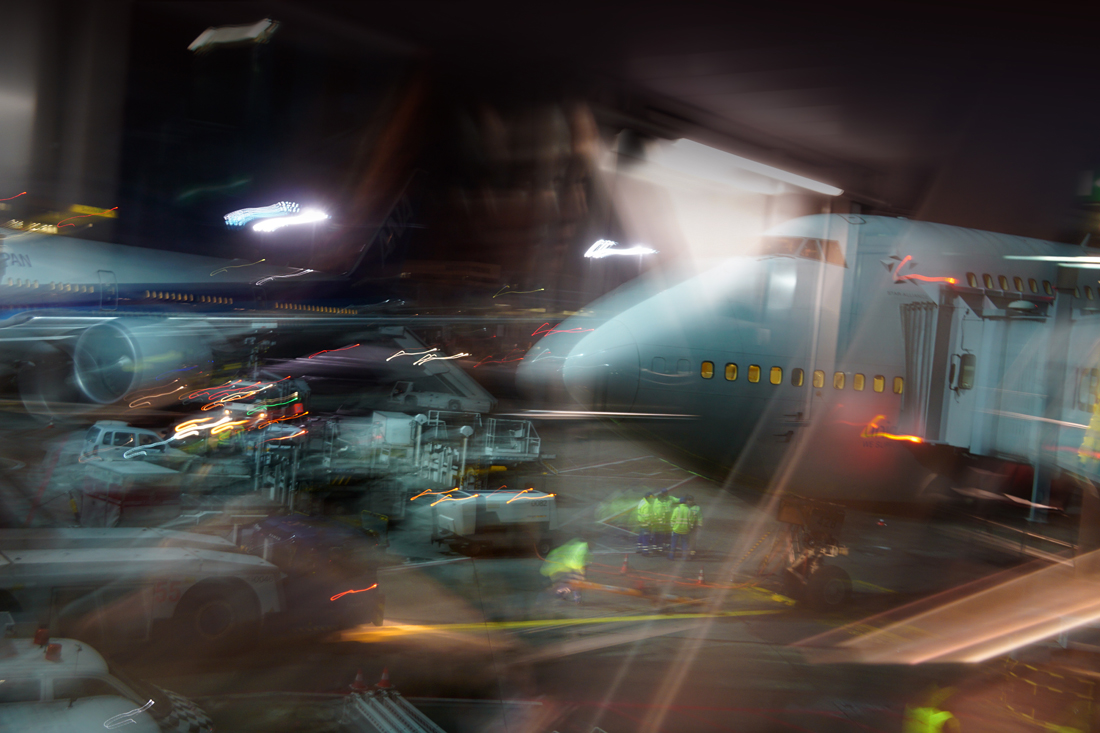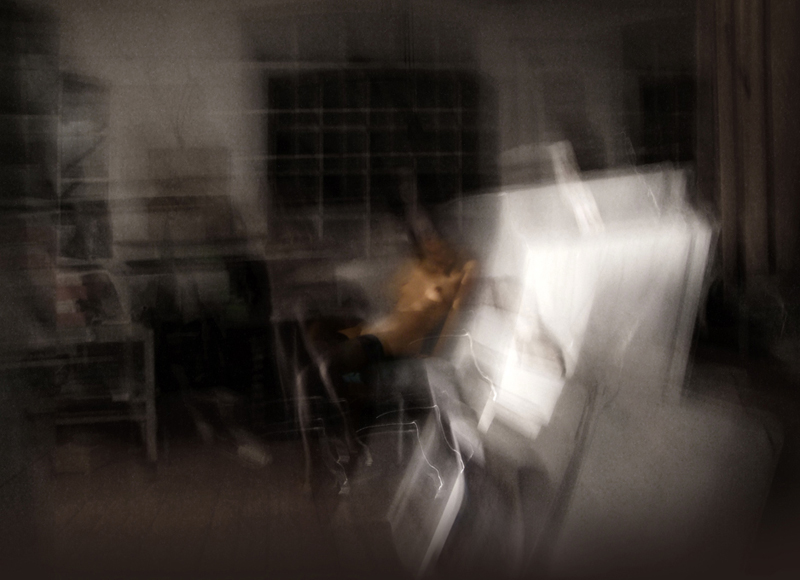Exposition: 18.3. – 30.4.2016
Galerie Mansart, 5, rue Payenne – 75003 Paris
Né en Allemagne en 1954, Tilmann Krieg propose un mode d’expression artistique original : la photographie picturale, à la croisée des chemins entre photographie et peinture, narration séquentielle et abstraction. L’artiste a développé une technique inhabituelle autour du mouvement et de supports comme l’acier, le cuivre ou l’aluminium. Il sacrifie la dimension documentaire de la photo pour privilégier le travail de la lumière comme signification autoréférentielle, offrant un traitement original du temps en photographie.
A la galerie Mansart, l’artiste présentera une exposition en trois chapitres, inspirée du film Sky Plane Girl de la réalisatrice russe Vera Storozheva. Chaque accrochage est un nouveau point de vue qui vient interroger la photographie.
Le premier, Sky, propose une construction spatiale autour de la répétition multiple d’une seule œuvre, travaillant la photo comme médium et méthode. Le deuxième chapitre, Plane, se présente comme une narration visuelle basée sur la géométrie des formes et témoigne de l’intérêt de l’artiste pour l’esthétique du déplacement, lui qui a exposé de Séoul à Bern, de Berlin à Addis Abeba. Enfin, Girl renouera avec un accrochage classique pour aborder un des thèmes majeurs de l’œuvre de Krieg : la figure féminine.
Sky : premier vernissage
Vendredi 18 mars, 19h
Evanescence « Evanaissances » ou du Néant, corrélatif de l’Etre
C’est les yeux fermés, en émergeant à peine d’un rêve, que ces photos, découvertes peu de temps avant l’exposition, ont défilé devant mon œil intérieur. J’ai alors réalisé que les règles de l’apesanteur, l’ordre chronologique et l’adjonction des ombres y sont aussi libres que dans nos rêves ; détachement qui permet au spectateur de revêtir, lui aussi, des ailes pour glisser sur le temps. Il en émane une douce et inquiétante impression du « déjà vu ».
Pourtant ces images, on les découvre dans leur authenticité qui accorde imagination et entendement dans la dynamique multiple et perpétuelle de l’Univers. Ces représentations singulières de fractions du Temps et sa nature fluente, à priori inintelligible, questionne aussi la manière de penser l’infinité, l’éternité, signifiant ou signifié tout comme la métaphysique de l’immanent et du transcendant.
Les photos de Tilmann Krieg figent le présent en racontant le passé, tout en anticipant l’avenir, montrant l’empreinte que les ombres laisseront quand elles ne seront plus, comme une éclipse où se confondent des êtres-formes et des formes de vie où les regards viennent de rien et se fixent sur rien dans un mouvement combinatoire intelligible du visible, de l’invisible et de l’entredeux, pour aboutir à une conscience simultanée. Gravitations d’une extrême amplitude sur la causalité inversée et le retour sur la séquence des causes… Ces plaques, blanchies par réaction chimique, font penser à Kandinsky « Le blanc sonne comme le silence, un rien avant tout commencement ».
Les mouvements dans Sky corrélé au référentiel d’inertie sont visibles dans les branches de l’arbre encore frémissantes du souvenir du poids de l’oiseau qui y avait pris appui pour se lancer dans le ciel ; frémissement faisant écho au ballet des nuages qui courent à l’horizon alors que l’oiseau lui, les ailes déployées dans le vide semble figé, tout comme le spectateur qui craint que l’oiseau ne décroche et tombe, tout en l’enviant d’être dans les airs…
Justement cette envie de voler, aussi vieille que le désir de la pomme, a abouti à la création d’oiseaux en fer, Plane, construits par les hommes pour s’arracher à la terre sans vraiment savoir s’ils vont atterrir, et où, et lorsqu’ils seront dans l’air le halo de leurs corps et de leurs âmes seront encore perceptibles à travers leurs ombres qui sont toujours un peu plus lentes. Un départ dont on ne connaît pas le retour dans ce floue composé de plusieurs espaces temps, télescopages d’univers parallèles en une seule image…
Le tempo de Girl est tout autre, elle, Femme Première scrute l’horizon ; la Lumière Messagère du Temps semble lui envoyer une flèche en forme de fleur en feu dans son sein, sans la perturber. Sereine, elle laisse le temps venir à elle, car elle est de tous les temps…
« Ich bin alles, was da ist, was da war, und was da sein wird, und meinen Schleier hat kein Sterblicher aufgedeckt »* E. Kant citant l’inscription du temple d’ISIS.
© Wally Thomas-Hermès & Dr. Thierry Martin Le Bour
English Translation by Giorgio Mauro:
Transience and resurgence Nothingness or the flip side of being
Eyes still closed, images appear before my inner eye as in a dream – these images I discovered shortly before the main exhibition. Like the appearances in our dreams, the images seem free. They rise unburdened above common rules, chronological narrative and realistic representation.
The resulting alienation effect hooks and draws the onlooker along – seduces him to put his own wings on too and start time-gliding with them. These images convey the sweet and at the same time disturbing impression of a “déjà vu”.
Yet one simultaneously recognizes an authenticity in them that, in its imaginative range and deeper understanding, reaches out to the immense variety and permanent dynamics of the universe. These vivid cuts in time in their fleeting particularity require – almost incomprehensibly at first sight – thinking outside of the box: eternity conceived in the metaphysical and transcendent sense.
Tilmann Krieg’s photographs capture the moment by recounting the past and anticipating the future. They show traces that left shadows when the traces are no longer there – in a intensification process that merges created forms with the forms of life. The glance seems to come from nowhere and be directed nowhere, in a motion both mysterious and revealing, making the unseen visible, and this unresolved tension leads to a new plane of the onlooker’s consciousness. Causality inverted and turned around in its sequence… These image panels, created by photographic – that is, chemical – reaction, call to mind Kandinsky: “White is the sound of silence, a nothing before all beginnings.”
In “Sky” (into the blue) the movement is still visible in the branches of the tree, which are still trembling in memory of the great bird that launched itself into the sky from his perch. It resonates, like an echo outlined against the cloud ballet in the sky, while the bird – wings spread out over the void, which is everything but empty – appears like frozen in his movements. The viewer is spellbound too. Will the bird crash down, he may think, wishing at the same time to be the one gliding freely through space…
It was this desire to fly – as old as the apple’s lure – that finally gave existence the birds of steel. Airplanes, built by humans to rise above the earth, without knowing whether they will ever land again and where, when they glide along at high altitude. Their bodies, their souls – still perceptible in their shadows, ever a little slower than themselves. A flight, whose return is not yet divinable in these blurred compositions of several layers of time, crystallized in a single image.
In “Girl”, the rhythm is completely different. She! First, Only and Forever Woman, mystery on the horizon. A ray of light, harbinger of time, as an arrow, as a flower made of fire envelops her, draws patterns on her breast, touches her skin, without invadence. Calm and cheerful she lets time flow to herself, for she herself is all time…
«I am everything that is, that was and that will ever be, and my veil has never been lifted by a mortal.» (Emmanuel Kant citing the inscription of the Isis temple)
© Wally Thomas-Hermès, Dr. Thierry Martin Le Bour

Plane : second vernissage
Vendredi 1er avril, 19h
„A photograph is both a pseudopresence and a token of absence. Like a wood fire in a room, photographs—especially those of people, of distant landscapes and faraway cities, of the vanished past—are incitements to reverie.“ Susan Sontag, On Photography
La photographie n’a jamais été mon cheval de bataille. Je lui ai souvent trouvé un fond de tricherie et de premier degré, qui ne permettrait pas les innovations que peuvent donner des peintures ou des installations. La photographie est trop brutale, directe vis-à-vis du spectateur. Elle lui donne tout, d’un coup. La photographie, cette narratrice brutale, impose le récit au spectateur. Elle est toujours l’instant d’une histoire, une image du réel que le spectateur est contraint de replacer dans le temps, lui rendant ainsi une caractéristique humaine.
Tilmann Krieg, lui, propose un mode d’expression artistique original : la photographie picturale, à la croisée des chemins entre photographie et peinture, narration séquentielle et abstraction. La technique est elle-même originale. Il s’aventure pour donner du mouvement à sa photographie, dans l’utilisation de supports comme l’acier, le cuivre ou l’aluminium. Il sacrifie la dimension documentaire de la photo pour privilégier le travail de la lumière comme signification autoréférentielle, offrant un traitement original du temps en photographie.
Les photographies de Tilmann Krieg font référence à une oeuvre, comme des cinéastes peuvent parfois s’inspirer de réalisations plus anciennes. Il veut capturer un instant de son propre film, une atmosphère qui en traduirait l’histoire. Chacun sait que la technique de réalisation rapproche la photographie du cinéma. La photographie a donné naissance au cinéma et, par cette référence au septième art, Tilmann Krieg témoigne de l‘ atmosphère pure et originelle du film qu’il souhaite raconter. D’une certaine manière, il permet au spectateur, en replaçant explicitement la photographie dans le temps, dans le récit du film, de pouvoir passer à une étape supérieure de réflexion.
A la Galerie Mansart, l’artiste présentera une exposition en trois chapitres, inspirée du film Sky Plane Girl de la réalisatrice russe Vera Storozheva. Chaque accrochage est un nouveau point de vue qui vient interroger la photographie.
Le premier chapitre, Sky, propose une construction spatiale autour de la répétition multiple d’une seule oeuvre, travaillant la photo comme médium et méthode. Le deuxième chapitre, Plane, se présente comme une narration visuelle basée sur la géométrie des formes et témoigne de l’intérêt de l’artiste pour l’esthétique du déplacement, lui qui a exposé de Séoul à Bern, de Berlin à Addis Abeba. Enfin, Girl renouera avec un accrochage classique pour aborder un des thèmes majeurs de l’oeuvre de Krieg : la figure féminine. Ainsi, l’exposition est la parabole de problématiques artistiques récurrentes : la théorie de l’art, l’aspect concret de l’art, par l’utilisation de la science, la géométrie et les matériaux qui lui sont propres et finalement le sujet de la femme, de l’être humain qui permet d’allier théorie et réalisation, réflexion et action.
Cette exposition me permet de sortir de mon confort, car l’oeuvre de Tilmann Krieg porte la critique de l’aspect narratif de la photographie, et la dépasse tout à fait. Son travail est un dialogue avec la nature même de la photographie.
Azad Asifovich, Curateur
Remerciements: David Gadmer
English Translation by Giorgio Mauro:
“A photograph is both a pseudo presence and a token of absence. Like a wood fire in a room, photographs —especially those of people, of distant landscapes and faraway cities, of the vanished past — are incitements to reverie.” Susan Sontag, On Photography
Photography has never been especially in the focus of my professional interest. It often seems artificial to me, constructed and inferior to other forms of art. Lacking that force of innovation of which painting, for instance, is capable, or artistic forms of installation. I have always thought of photography as rather brutal, always aiming straight at the eye of the beholder. Sometimes nearly knocking him off, by its sheer presence. Photography is a brutal storyteller that forces its view of the story on the viewer. As if it always claimed the quintessence of a story for itself – an implicit reality that makes it difficult for the viewer to replace or elaborate on these frames of reference with an image of his own.
Tilmann Krieg on the other hand follows a completely different path of artistic expression: painted photography, situated exactly at the cross-roads between photographic painting, narrative fabulation and abstraction. His technique, too, is self-reliant and original. He accepts and delves into the motion traces of his photography, reinforcing them even, by the use of diverse unusual support materials, such as steel, copper or aluminum.
The documentary character of a photograph thus recedes into the background or disappears completely, making room for playful properties of light, which becomes not merely a medium of photographic painting, but additionally unfolds a multitude of effects on the reflecting surfaces of the support material. The result generates an original and unique work, a discourse on time for which the artist uses photographic means. Tilmann Krieg’s works relate to photography as a whole, in all its essential components – just as cinematographers often reach back to their own early works for inspiration.
Krieg aims at a short moment of his own film, an atmosphere capable to transport the historical moment and make it felt. Photography has bred cinema and Tilmann Krieg relates to this “seventh” form of art in his dense and original narrative approach. In a certain way he enables the viewer to notice or discover the dimension of time in a cinematographic paraphrase that takes manifest form in a comprehensive picture. Galerie Mansart features the artist in an exposition consisting of three chapters, inspired by the film “Sky, Plane, Girl” of the Russian film director Vera Storozheva. Each positioning of a picture signifies a new point of view, questioned and challenged with the tools of photography.
The first chapter “Sky” consists of a sort of spatial installation created by multiple repetition of a single piece of work. The photograph becomes both medium and method. The second chapter “Plane” has the effect of a visual narrative, based on the geometry of shapes and the aesthetics of their displacement and doubling. “Girl”, finally, reveals one of the mainstays of Tilmann Krieg’s oeuvre in a classical way: the female form.
This exposition is like a parabolic mirror that bundles themes ever recurring in art, motives Tilmann Krieg also keeps returning to: both theoretical and concrete aspects of art, integrating science, geometry and autonomous materiality and, last but not least, the Woman, the being whose very essence makes it possible to reunify theory and realization, reflection and action.
This exposition of Tilmann Krieg, who has exhibited before in Seoul, Berne, Berlin, Addis Abeba and the US among many others, is exceptional to me. Tilmann Krieg’s work no doubt transports a narrative aspect but immediately transcends it, lifting the viewers glance beyond the immediate story. His oeuvre appears in dialogue both with nature itself and with the phenomenon of photography.
Azad Asifovich, Curator of the exposition Sky.Plane.Girl
Special thanks to David Gadmer


